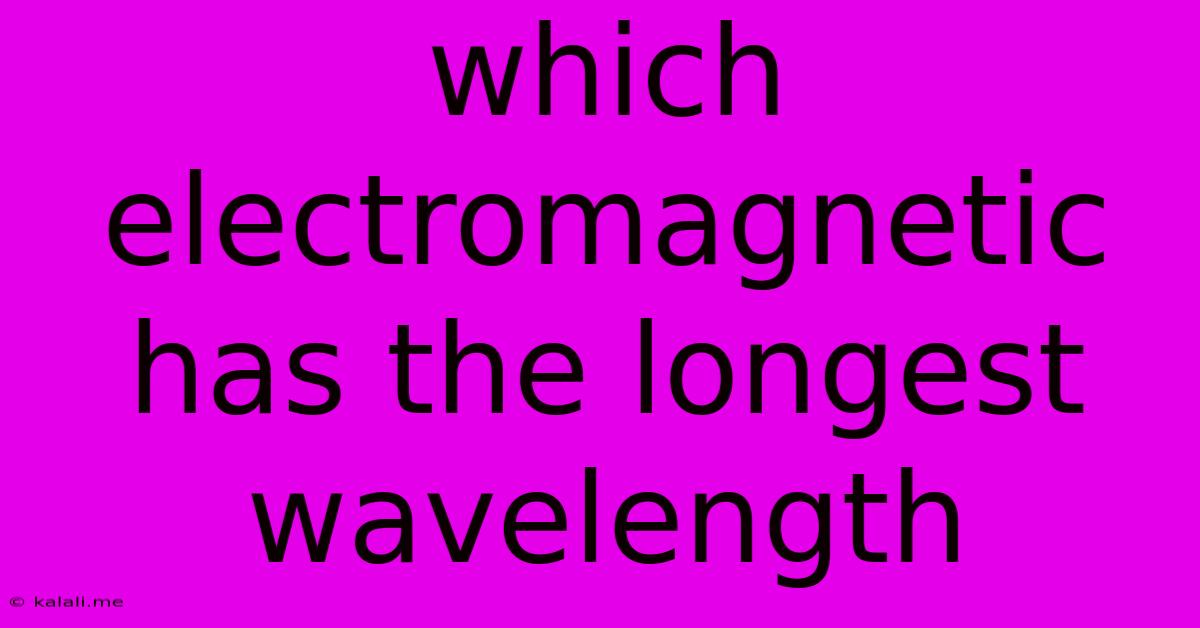Which Electromagnetic Has The Longest Wavelength
Kalali
Jun 13, 2025 · 2 min read

Table of Contents
Which Electromagnetic Wave Has the Longest Wavelength?
Radio waves hold the title for possessing the longest wavelengths within the electromagnetic spectrum. This article delves into the fascinating world of electromagnetic radiation, exploring the characteristics of radio waves and their position relative to other forms of electromagnetic energy, such as microwaves, infrared, visible light, ultraviolet, X-rays, and gamma rays. Understanding the electromagnetic spectrum and the properties of its constituent waves is crucial for various scientific and technological applications.
Radio waves, characterized by their exceptionally long wavelengths, typically range from millimeters to kilometers. This vast range allows them to be used for various purposes, from broadcasting radio signals and television programming to facilitating communication with satellites and navigating using GPS systems. The extended wavelength of radio waves enables them to penetrate the Earth's atmosphere and travel long distances with minimal attenuation, making them ideal for long-range communication. This characteristic contrasts sharply with shorter wavelength electromagnetic waves which are more easily absorbed or scattered.
Let's compare radio waves to the other parts of the electromagnetic spectrum:
- Microwaves: While microwaves also have practical applications, including cooking and communication, their wavelengths are significantly shorter than radio waves, typically measuring in centimeters.
- Infrared Radiation: Infrared radiation, responsible for heat transfer, has even shorter wavelengths than microwaves, falling within the micrometer range.
- Visible Light: The wavelengths of visible light are much shorter than infrared, ranging from approximately 400 to 700 nanometers.
- Ultraviolet Radiation: Ultraviolet radiation, with wavelengths shorter than visible light, is responsible for sunburns and is also used in sterilization processes.
- X-rays: X-rays have even shorter wavelengths than ultraviolet radiation, allowing them to penetrate soft tissues and are widely used in medical imaging.
- Gamma Rays: Gamma rays possess the shortest wavelengths within the electromagnetic spectrum, often measured in picometers or even femtometers. They are extremely high-energy and are emitted from radioactive materials.
The relationship between wavelength and frequency is inversely proportional; as wavelength increases, frequency decreases, and vice versa. Therefore, radio waves, with their longest wavelengths, also possess the lowest frequencies within the electromagnetic spectrum. This low frequency is a key factor in their ability to travel long distances. The lower energy associated with these longer wavelengths also makes them relatively safe compared to higher-frequency electromagnetic radiation.
In summary, the electromagnetic wave with the longest wavelength is the radio wave. This defining characteristic is fundamental to its numerous applications in communication, navigation, and other technological fields. Understanding the properties of the electromagnetic spectrum, including the relationship between wavelength and frequency, is essential for appreciating the diverse roles played by these waves in our world.
Latest Posts
Latest Posts
-
Which Of The Following Are Characteristics Of Prokaryotes
Jun 14, 2025
-
Census Data Is An Example Of Primary Data
Jun 14, 2025
-
What Is The Lcm Of 6 8 And 9
Jun 14, 2025
-
What Is The Prime Factorization Of 86
Jun 14, 2025
-
What Is The Lcm For 36 And 45
Jun 14, 2025
Related Post
Thank you for visiting our website which covers about Which Electromagnetic Has The Longest Wavelength . We hope the information provided has been useful to you. Feel free to contact us if you have any questions or need further assistance. See you next time and don't miss to bookmark.